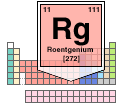The Periodic Table

See the interactive periodic table.
 |
Although some elements, such as gold and iron, have been known to humans since prehistoric times, it wasn't until the 17th century that the first scientific discovery of an element (phosphorus) was made. Only 12 elements were known prior to 1700, but as more and more elements were discovered—by 1900 there were more than 80—scientists tried to find a way to organize them systematically, according to their physical and chemical properties.
Today, the periodic table organizes the elements in horizontal rows, or periods, by order of increasing atomic number, which equals the number of protons in the atomic nucleus of each element. The elements are also organized in vertical columns, or groups, based on similar physical characteristics and chemical behavior. This arrangement developed side by side with atomic theory over about 200 years, and it continues to evolve as new elements are discovered.
Early Attempts
One of the earliest attempts to organize the elements based on their chemical and physical properties was made by German chemist Johann Dobereiner. In 1817 Dobereiner noticed that certain elements that were chemically similar could be grouped together in threes, for example, calcium, strontium, and barium; lithium, sodium, and potassium; chlorine, bromine, and iodine. In each group of three, the atomic weight of one element fell halfway between the atomic weights of the other two elements. The pattern seemed too remarkable to be a coincidence. Based on his findings, Dobereiner proposed the Law of Triads in 1829. His work soon prompted other scientists to find patterns among even larger groups of elements.
Another attempt to systematically organize the elements based on their properties was made by the French geologist Alexandre-Émile Beguyer de Chancourtois in 1862. He devised a kind of spiral graph that was arranged on a cylinder, with the elements ordered by increasing atomic weight and with similar elements lined up vertically. De Chancourtois was the first to notice the periodicity of the elements, that is, when the elements were arranged according to their atomic weights, similar elements seemed to occur at regular intervals.
A year later, the English chemist John Newlands also attempted to classify the known elements of his day based on their atomic weight. Like de Chancourtois, he noticed a repeating pattern—every eighth element had similar properties. Newlands called this the Law of Octaves. Although the tables worked out by both de Chancourtois and Newlands were important precursors to the periodic table, neither received much attention at the time.
Mendeleev
The next milestone in the development of the periodic table was set by the Russian chemist Dmitri Mendeleev, who is generally acknowledged as the “father” of the modern periodic table. Mendeleev wrote out the names of the elements, along with their atomic weights and other properties, on cards, which he then laid out in rows and columns much like a game of solitaire. When the elements were ordered according to atomic weight, Mendeleev, like de Chancourtois and Newlands, could see that certain chemical properties were repeated periodically; however, not all the elements fit this pattern neatly. Mendeleev's solution was to move certain elements to new positions, despite their accepted weight, in order to group them with other elements sharing similar properties. (Nearly half a century later, after the periodic table was revised according to atomic number rather than atomic weight, these elements fell into place.)
Mendeleev's work on periodic law—which states that the properties of elements recur periodically as their atomic weights increase—was announced in 1869. At about the same time, a German chemist named Julius Lothar Meyer independently arrived at a periodic table that was remarkably similar to Mendeleev's. Unfortunately for Meyer, Mendeleev presented his work to the scientific community first. However, Mendeleev's table was also superior to Meyer's because he left a number of empty spaces to account for elements that were yet to be discovered.
20th-Century Revisions
The first major change to the periodic table occurred following the discovery of an entirely new group of elements, the noble gases, between 1895 and 1901. They were called the noble gases because they were believed to be inert—incapable of reacting with other elements to form compounds. (Today it is known that they do enter into chemical combinations, only reluctantly.) These elements were simply added on in a separate column under helium.
The first major revision of the entire periodic table was carried out by Henry Gwyn-Jeffries Moseley, an English physicist who began his research under Ernest Rutherford. In 1914, Moseley showed that each atomic nucleus could be assigned a number that was equal to the number of units of positive charge (later identified as “protons”) associated with it. Once the periodic table was reorganized according to this atomic number instead of atomic weight, the few discrepancies in Mendeleev's system disappeared.
Over the years other revisions of the table have been made, including the incorporation of the rare-earth elements (lanthanide series) and the synthetic elements (technetium, promethium, and all the elements with atomic number 93 or higher). The actinides, which are radioactive and mainly synthetic, and the lanthanides do not fit into the same pattern of repeated properties as the other elements, so they are generally shown below the periodic table in separate rows. Most of these changes were the work of American chemist Glenn Seaborg, who codiscovered elements 94 (plutonium) through 102 (nobelium) between 1940 and 1958. Seaborg also suggested a superactinide series of elements, with atomic numbers 122 through 153, but so far none of these has been synthesized or detected.
